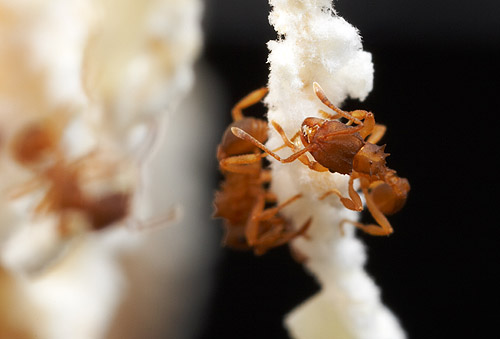An image I took a couple years ago at UT Austin is featured today in Nat Geo's "Photo in the News". This laboratory nest was one of the colonies screened in Anna Himler's study to determine that the species is parthenogenetic.
One correction to the Nat Geo article. Mycocepurus are not leafcutter ants themselves but part of an earlier radiation of fungus-growers.
- Log in to post comments


Congrats Alex! Probably won't be the last time NG will coming knocking, either.
Clay
Great photo - almost like the ants are blurring into their evolutionary past from right to left. Maybe there is a non-sterile worker in amber just out of frame.
Interesting paper too, but I find the persistence of the mistaken idea that asexual reproduction is rare or that asexual lineages can't persist over time strange. Prokaryotes don't seem to have had a problem persisting for 4 billion years or so. Lots of eukaryote asexual lineages (plants, rotifers, worms, ostracods, mites, insects ...) seem to be doing very well. Really, the question should be why are asexual vertebrates so rare.
I wasn't the only one to instantly think of Bdelloid rotifers!
There's an interesting paper by Rosie Redfield 2001 in Nature Rev Genet "Do bacteria have sex?". It seems that recombination is a byproduct of DNA repair mechanisms -- they occasionally 'repair' foreign DNA into their genomes, and very rarely this foreign DNA does good. Otherwise, the change is unnoticed or the bacterial lineage dies out. People have considered all these beneficial foreign-origin genes to be a sign of the benefits of recombination while completely forgetting the fact they're only seeing the success stories. To use Redfield's analogy, it's like assuming that every lottery ticket is a winner based on what you see on the news.
To take this further to the remaining 1% of biodiversity, one must look at the vast majority of eukaryotic life -- protists. Most of them do quite well without sex, although more and more lineages are found to be capable of meiotic sex. There are some lineages that can't live without sex (diatoms, ciliates, many multicellular forms) -- but the thinking that sex was invented by them to survive is fundamentally backwards -- it's more likely that sex ENABLED those lineages to develop problematic situations that subsequently require it. A diatom that cannot do sex would not be able exist -- they'll just shrink into oblivion!
(When diatoms divide, the lower valve becomes the top part, and a smaller bottom valve is formed de novo. This means that the population gets increasingly smaller with each asexual generation -- they must conjugate to form new large valves!)
Sex may have actually been invented by transposons -- of all entities, parasites have the greatest interest in interaction between organisms to they can jump to new lineages. A key enzyme in the mating type switching in yeasts seems to have originated from a transposon (see discussion in Keeling and Roger 1995 Nature)... if a transposon figures out a way to induce its host to have sex, that's a very favoured strategy for that mobile element.
Incidentally, I'm working through Tom Cavalier-Smith's 2002 paper on evol of sex+recombination in eukaryotes, so this entry is very relevant at the moment!
I have a physchem final tomorrow... can you tell? Should probably start taking care of that...
-Psi-
I'm happy to have found your site and blog, i just wanted to stop by to say you have some amazing, beautiful work.